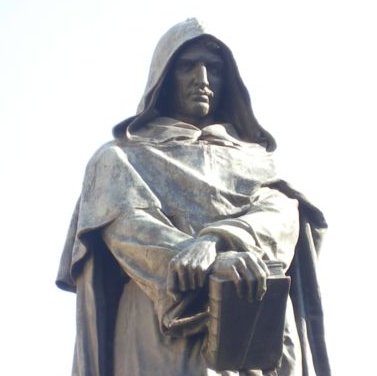by Lawrence MacLachlan
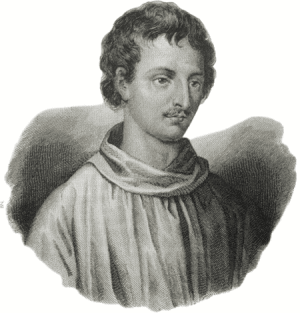
"Innumerable suns exist; innumerable earths revolve around these suns in a manner similar
to the way the seven planets revolve around our sun. Living beings inhabit these worlds."
"An academician belonging to no academy", an unfrocked monk, an excommunicated Calvinist, an expelled Lutheran, an avant-garde and marginal philosopher, a forgotten genius of the Renaissance - Giordano Bruno was also an inspired magus.
http://www.bruno-giordano.net/
Brief Biography from The Galileo Project
Giordano Bruno: Italian philosopher original name Filippo Bruno, byname Il Nolano born 1548, Nola, near Naples died Feb. 17, 1600, Rome. Encyclopedia Britannica Online.
Giordano Bruno: Wikipedia
Life and works of Giordano Bruno: Esoteric Online
The Forbidden World: The New Yorker (August 25, 2008)
Procedure of the Roman Inquisition: It was strict Holy Office practice to keep detailed records of all its proceedings from the first summons to the final sentencing. This was intended to discourage the inclination to ask leading questions which would suggest to the accused how they should reply. A permanent member of every court of inquisition was the Notary, who took down in writing every question and every answer, including the exclamations of pain emitted by the victims of torture. Each official took a solemn vow of secrecy, held interrogations in strict privacy, and carefully guarded the records of trial proceedings. There were several reasons for this. First, witnesses had to be protected from possible retaliation by the family and friends of the accused. Second, once a defendant named his accomplices, the Holy Office might have to move swiftly to bring them into custody. If word leaked out to them before they could be apprehended, the system would not be very effective. Third, the reputation of the accused had to be protected. It was often reiterated that inquisitors should act cautiously when making an arrest.
1592 – 1600 From the Trial to the Stake: Giordano's trial lasted almost eight years. The Inquisition initially accused him for his anti-dogmatic ideals, which had already cost him his Dominican habit. As an anti-Trinitarian, the philosopher rejected the virginity of Mary and transubstantiation. His reflections in terms of cosmology, his rejection of geocentrism and his attraction for magic gradually gave rise to an impressive list of accusations. In the end, it was the whole of his freethinking that was challenged. In February 1593, Bruno was incarcerated in the prisons of the Holy Office. The trial dragged on for another two years before the decision was taken to conduct an in-depth study of his works, which were censured and subsequently burned at St Peter's Square. From his cell, Bruno finished writing a statement for his defence and presented his final plea on 20 December 1594 before the Holy Office. The trial was interrupted for six months, during which time Bruno continued to actively defend his theory on infinite worlds, sometimes stating that he was ready to recant, and at other times declaring that he was faithful to his ideas. Cardinal Bellarmin therefore drew up a list of the theories deemed to be heretical, over which Bruno again hesitated before categorically refusing to renounce his doctrine: The eight propositions that the philosopher refused to renounce were as follows:
1 - The statement of "two real and eternal principles of existence: the soul of the world and the original matter from which beings are derived".
2 - The doctrine of the infinite universe and infinite worlds in conflict with the idea of Creation: "He who denies the infinite effect denies the infinite power".
3 - The idea that every reality resides in the eternal and infinite soul of the world, including the body: "There is no reality that is not accompanied by a spirit and an intelligence".
4 - The argument according to which "there is no transformation in the substance", since the substance is eternal and generates nothing, but transforms.
5 - The idea of terrestrial movement, which according to Bruno, did not oppose the Holy Scriptures, which were popularised for the faithful and did not apply to scientists.
6 - The designation of stars as "messengers and interpreters of the ways of God".
7 - The allocation of a "both sensory and intellectual" soul to earth.
8 - The opposition to the doctrine of St Thomas on the soul, the spiritual reality held captive in the body and not considered as the form of the human body.
None of these final accusations tied in with the philosopher's magic reflections. Nevertheless, the Inquisition accused him of having turned towards hermetism and the arcane, branding him a sorcerer for having written in On Heroic Frenzies that "Magi can accomplish more using the faith than doctors using the ways of liberty" and for recognising magic as beneficial and lawful. Whatever the case, on 20 January 1600, Pope Clement VIII declared that the accused was "an unrepentant heretic, tenacious and stubborn". Taken to the secular arm, Cardinal Madruzzi pronounced the sentence on 8 February. Giordano Bruno was burnt at the stake in Campo dei Fiori in Rome around 10 days later. Defiant to the very end, Bruno looked away from the crucifix before perishing in the flames.
Summary of the Trial Against Giordano Bruno, Rome 1597: From the Vatican Archives.
In one of the volumes of the “Miscellanea Armadi” (Arm. X, 205) by the famous canonist Francisco Peña, Auditor and then Dean of the Rota, there is a precious document, searched for a long time, then kept secret for a long time and finally found on the 15th November 1940 after 15 years of unsuccessful investigation by the Prefect of the Vatican Archives, Angelo Mercati: the summary of the trial against Giordano Bruno. The human vicissitudes of Giordano Bruno ended with the Roman trial (1593-1600) and with the sentence of proven heresy, which, due to his resolute and extreme statement of not being guilty, changed into capital punishment, executed at Campo de’ Fiori on the 17th February 1600. In one of the last interrogations before the execution of the sentence (maybe in April 1599), the Dominican friar was questioned by the judges of the Holy Office on his cosmogony conception, supported above all in the “La cena delle Ceneri”(Ash-Wednesday Dinner) and in the “De l’infinito universo et mundi”. Even then, he defended his theories as scientifically founded and by no means against the Holy Scriptures.
The Folly of Giordano Bruno : by Prof. Richard W. Pogge, Ohio State University
In popular accounts of the life of Bruno, it is often said that he was condemned for his Copernicanism and his belief in life on other worlds. He is portrayed as a martyr to free thought, and an early, prosecuted proponent of the modern view of the universe, hounded across Europe by the Inquisition for his beliefs and finally paying the ultimate price for them in a fiery public death. The one key fact of the study of Bruno's life is that we do not actually know the exact grounds of his conviction on charges of heresy. The simple reason is that the relevant records have been lost. The second often overlooked fact of Bruno's life concerns his period of exile between 1576 and 1591. Most brief popular accounts state the bare facts of his peregrinations around Europe, but what is left unsaid is that his wanderings appear to have had less to do with his being hounded by the Inquisition as it did with his own rather difficult personality.
The Catholic Encyclopedia: Bruno’s system of thought is an incoherent materialistic pantheism. God and the world are one; matter and spirit, body and soul, are two phases of the same substance; the universe is infinite; beyond the visible world there is an infinity of other worlds, each of which is inhabited; this terrestrial globe has a soul; in fact, each and every part of it, mineral as well as plant and animal, is animated; all matter is made up of the same elements (no distinction between terrestrial and celestial matter); all souls are akin (transmigration is, therefore, not impossible). This unitary point of view is Bruno's justification of "natural magic." No doubt, the attempt to establish a scientific continuity among all the phenomena of nature is an important manifestation of the modern spirit, and interesting, especially on account of its appearance at the moment when the medieval point of view was being abandoned. (Turner, W. (1908). Giordano Bruno. In The Catholic Encyclopedia. New York: Robert Appleton Company. Retrieved February 12, 2009 from New Advent
Great Theosophists - Giordano Bruno
The Mysterious Case of Crater Giordano Bruno
Ingrid Rowland's Giordano Bruno: Philosopher/Heretic is an excellent starting point for anyone who wants to rediscover the historical figure concealed beneath a cowl on Campo de' Fiori. Her lively and learned biography removes Bruno from myth and polemic, where he has so often resided, and restores him to the time and place that inspired his dual passion for knowledge as well as faith. She also offers a far richer and multidimensional account of Bruno's peculiar and complex intellectual itinerary than earlier scholars like Frances Yates, who, in her brilliant and influential account Giordano Bruno and the Hermetic Tradition (1964), depicted him as a great Renaissance magus. She inspired a generation of readers to see him primarily as a Hermetic philosopher devoted to the restoration of Egyptian wisdom. Generously acknowledging the more recent work of Bruno specialists like Hilary Gatti, who have shown us how to read his politics, philosophy, science, plays and poetry seriously, Rowland describes how Bruno became the kind of person who fascinated and alarmed virtually everybody who came into contact with him. She takes us inside his head to see the interplay of theology, philosophy and poetry that shaped his worldview. From A Hungry Mind: Giordano Bruno, Philosopher and Heretic in The Nation
The Ash Wednesday Supper / La Cena De La Ceneri; Translated with an Introduction and Notes by Stanley L. Jaki.
Bibliotheca Bruniana Electronica/ The Complete Works of Giordano Bruno : All texts in pdf with extensive biographies and other studies.
Additional Reading:
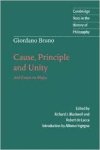
Blackwell, Richard and de Lucca Robert, eds., 1998, Giordano Bruno: Cause, Principle and Unity and Essays on Magic (Cambridge University Press).
Broderick, James, 1961, Robert Bellarmine, Saint and Scholar (Westminster, MD.: Newman Press)
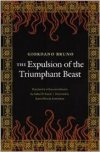
Bruno, Giordanao (translation by Arthur Imerti, 1964), The Expulsion of the Triumphant Beast (University of Nebraska Press).
di Santillana, Giorgio, 1955, The Crime of Galileo (Chicago: Univ. of Chicago Press)
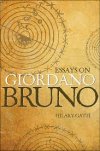
Gatti, Hilary, 2010, Essays on Giordano Bruno.
Riehl, Agnes, 1889, Giordano Bruno: In Memoriam of the 17th February 1600 (translation by Agnes Fry, 1900).
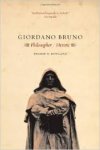
Rowland, Ingrid D., 2008, Giordano Bruno: Philosopher/Heretic (University of Chicago Press).
Singer, Dorothea Waley, 1950, Giordano Bruno, his Life and Thought. (New York: Schuman) [contains an annotated translation of On the Infinite Universe and Worlds]
White, Andrew Dickson, 1896, The Warfare of Science with Theology in Christendom (New York: D. Appleton & Company), 1978 reprint.
Yates, Frances, 1964, Giordano Bruno and the Hermetic Tradition (Chicago: Univ. of Chicago Press)
A number of Bruno's writings (most in Latin) are now available at the Twilit Grotto -- Esoteric Archives, including De Umbris Idearum ("The Shadow of Ideas"), Ars Memoriae ("Art of Memory"), De Gli Eroici Furori ("The Heroic Frenzies"), Cantus Circaeus ("Incantations of Circe"), De Magia, Theses De Magia, Magia Mathematica and De Vinculiss in Genere.
http://www.historyguide.org/intellect/bruno.html
